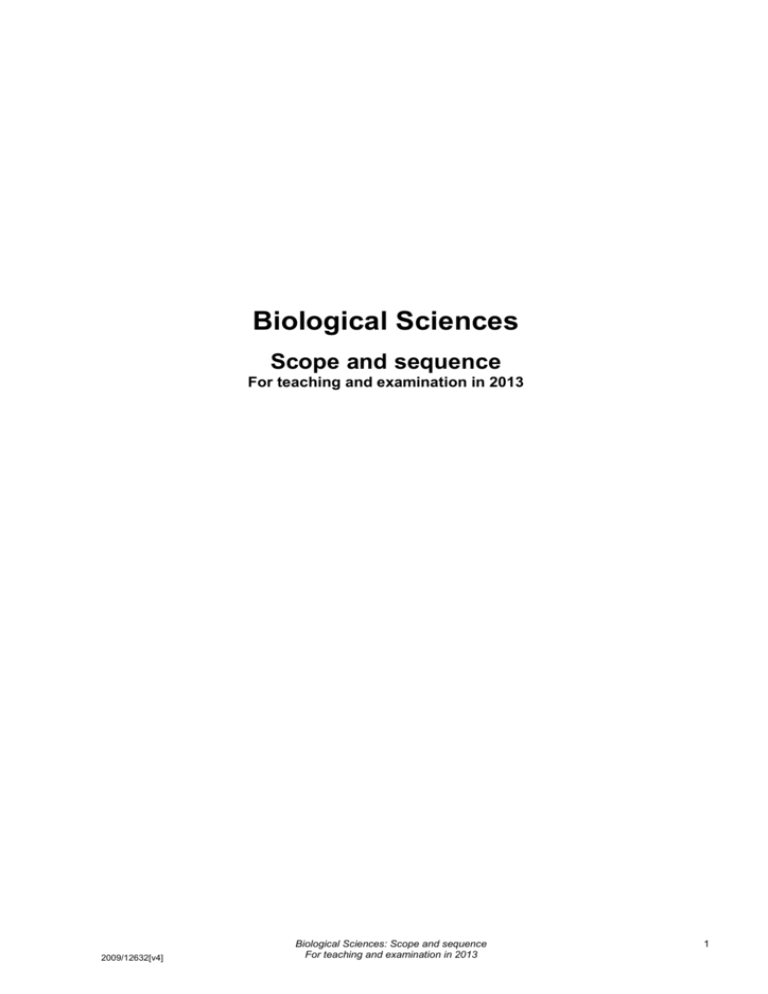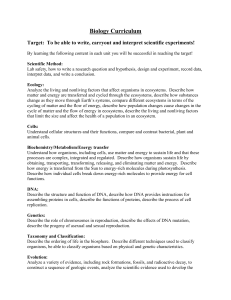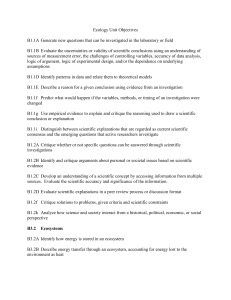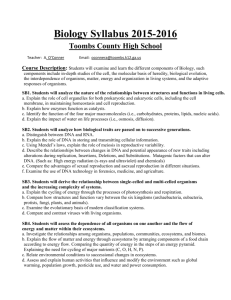Biological Sciences—Scope and sequence of content
advertisement

Biological Sciences Scope and sequence For teaching and examination in 2013 2009/12632[v4] Biological Sciences: Scope and sequence For teaching and examination in 2013 1 Copyright © Curriculum Council, 2009 This document—apart from any third party copyright material contained in it—may be freely copied, or communicated on an intranet, for non-commercial purposes by educational institutions, provided that it is not changed in any way and that the Curriculum Council is acknowledged as the copyright owner. Teachers in schools offering the Western Australian Certificate of Education (WACE) may change the document, provided that the Curriculum Council’s moral rights are not infringed. Copying or communication for any other purpose can be done only within the terms of the Copyright Act or by permission of the Curriculum Council. Copying or communication of any third party copyright material contained in this document can be done only within the terms of the Copyright Act or by permission of the copyright owners. Currency statement This document may be subject to minor updates. Users who download and print copies of this document are responsible for checking for updates. Advice about any changes made to the document is provided through the Curriculum Council communication processes. 2 Biological Sciences: Scope and sequence For teaching and examination in 2013 Biological Sciences—Scope and sequence of content UNIT 1A UNIT 1B UNIT 2A UNIT 2B UNIT 3A UNIT 3B Ecosystems are dynamic and respond to variations to maintain balance. Human use and activity alters the productivity and stability of the ecosystem. Ecosystem resilience relies on maintaining biodiversity in order to be sustainable and productive. Conservation strategies are developed to address environmental challenges—natural or human induced. Ecosystems: biodiversity and sustainability There is a huge diversity of organisms and each has a particular place in its environment. Organisms can be classified using similarities and differences in their features. diversity of life and reasons for diversity including classification of organisms structural characteristics used by biologists to classify organisms the flow of energy through food chains the word equations and the roles of photosynthesis and respiration the role of organisms, including producers and consumers and decomposers, in a food chain relationships between organisms including predator—prey, symbiosis and parasitic. Ecosystems differ in abiotic and biotic factors which cause changes in the flow of energy and materials. Interdependence affects the survival of organisms. major ecosystems (biomes) of the world the flow and transfer of energy through an ecosystem loss of energy throughout the food chain the cycling of matter through an ecosystem the role and significance of water in the biosphere the transfer of matter and energy through food webs and pyramids abiotic and biotic factors within an ecosystem the interdependence of organisms in food webs including the effects of an increase or decrease in the numbers of one type of organism on other organisms in the food web the interactions between organisms including competition, predation, parasitism and symbiosis the influence of human activities on food webs. Organisms are classified according to their features and roles in the ecosystem. Ecosystems are made up of populations of different organisms that interrelate. Cycling of matter varies between ecosystems and is influenced by abiotic and biotic factors in their ecosystem. Classification biological classification as a hierarchical system of grouping organisms the main classification groups used in biology: kingdom, phylum, class, order, family, genus, species different criteria are used at each level of classification binomial nomenclature and the use of taxonomic keys. Communities relationships between biosphere, ecosystem, community and population role of organisms including autotrophs, heterotrophs and decomposers in the ecosystem energy flow and dissipation in food chains, webs and pyramids. Population size, density, distribution and growth are affected by the features of the ecosystem. Human activities impact both negatively and positively on population dynamics and viability. Population dynamics relationships between organisms in communities and their impact on population size and distribution including competition, predator/prey, mutualism, collaboration, parasitism and commensalism and disease regulation of population by density dependent and density independent factors including natural disasters, disease, availability of resources, predator control, pest species and human activities carrying capacity of an ecosystem impact of population change on ecosystems the influence of population dynamics including birth, death and migration rates on: population size density composition distribution population calculations using birth, death and migration rates. Biological Sciences: Scope and sequence For teaching and examination in 2013 Biodiversity biodiversity in terms of genetic, species and ecosystem. Ecosystems natural, agricultural and urban ecosystems input and outputs amount of recycling stability productivity energy flow. Environmental issues and human impact causes and biological consequences of changes to natural, agricultural and urban ecosystems that result from human activity eutrophication dryland salinity harvesting of natural resources climate change fire biomagnification. Conservation rationale for the effective conservation of biodiversity within natural ecosystems conservation projects and strategies for maintaining biodiversity and the prevention of extinction including: genetic strategies including gene/seed banks, captive breeding programs, DNA profiling and development of new strains environmental strategies including biological control, revegetation, introduced species and pest control management strategies including national parks, protected zones, licences and open seasons. 3 UNIT 1A UNIT 1B UNIT 2A UNIT 2B Ecosystems: biodiversity and sustainability Cycling of matter matter cycles through abiotic and biotic components of the ecosystem the carbon cycle. Productivity in communities comparison of biomass in different trophic levels comparisons of productivity between communities. 4 Biological Sciences: Scope and sequence For teaching and examination in 2013 UNIT 3A UNIT 3B UNIT 1A UNIT 1B UNIT 2A UNIT 2B UNIT 3A UNIT 3B The functioning organism Differences between organisms at the cellular level relate to the features of organisms with particular lifestyles and living in particular habitats. adaptations of plants and animals including: structural behavioural physiological cells as the basic units of living organisms structures and functions of organelles including: chloroplasts nucleus plasma membranes cytoplasm cell wall structural and functional differences between cells in plants, animals and protists comparison of different tissues, organs or systems from selected organisms. Plants and animals are specialised in different ways to solve similar life problems, including acquiring energy and nutrients, support and protection. requirements of living organisms: energy, oxygen, water, nutrients, removal of wastes and reproduction structures and systems of organisms including microorganisms, plants and animals that enable them to acquire energy and nutrients structures and systems of organisms including microorganisms, plants and animals that provide support for the body and offer protection from the environment and predators. Living organisms require inputs and produce outputs that need to be exchanged with the environment. Energy requirements of organisms are reflected in their lifestyle, energy source and cellular contents. Adaptations for solving the problems of survival in a particular habitat are reflected at the cellular and organsystem level. Requirements of living organisms requirements of living organisms energy gases water nutrients removal of wastes energy flow in organisms: roles of photosynthesis respiration (word equations, no details of pathways required) the nature and role of carbohydrates lipids and proteins in living organisms. Cellular structures and functions structures and functions of cytoplasm and listed organelles nucleus mitochondria chloroplasts plasma membrane cell wall vacuoles compare eukaryotic and prokaryotic cells compare plant and animal cells. Exchange of materials exchange of substances between the organism and its environment diffusion osmosis factors affecting the rate of exchange of materials surface area to volume ratio concentration gradient. Biological Sciences: Scope and sequence For teaching and examination in 2013 Control of cellular processes is necessary for the survival of the organism. Control is affected by environmental conditions and cellular contents and requirements. Organisms use homeostatic mechanisms to control metabolic activity in order to survive in changing environments. Photosynthesis light dependent and light independent reactions in terms of the sites at which they occur, requirements and products factors affecting the rate of photosynthesis. Respiration anaerobic and aerobic respiration in terms of sites at which they occur, requirements and products of plants and animals factors affecting the rate of cellular respiration. Surface area to volume ratio cellular and organism level. Energy transfer importance of ATP and ADP cycles for cell functioning. Control of cellular activities transport of materials across the cell membrane active transport including carrier molecules, endocytosis and exocytosis passive transport including diffusion, osmosis and facilitated diffusion model for the structure and function of the cell membrane enzyme action: lock and key, induced fit, activation energy changes enzymes as specific catalysts effect of temperature and pH on enzyme action importance of enzymes in biological processes, including the control of biochemical pathways. 5 UNIT 1A UNIT 1B UNIT 2A UNIT 2B UNIT 3A The functioning organism Adaptations Adaptations may be structural, physiological or behavioural. Plants and animals have adaptations to survive in terrestrial and aquatic habitats. Use local examples, where possible, to examine adaptations for: transport the transport of materials in plants the transport of materials in animals including open and closed systems gas exchange gas exchange surfaces and the diffusion of oxygen and carbon dioxide significance of surface area to volume ratio acquiring nutrients acquisition of nutrients by animals including carnivores, herbivores, omnivores, detritivores, parasites acquisition of nutrients by plants, fungi and bacteria including photosynthetic, chemosynthetic, saprophytic, parasitic, insectivorous. Homeostasis the principles of homeostasis and negative feedback need for maintenance within limits of an organism’s internal environment for: carbon dioxide oxygen wastes temperature salts water. Homeostasis in animals factors affecting water balance water inputs water loss nitrogenous wastes from different vertebrate groups in relation to water availability factors affecting salt balance temperature regulation endothermy/ectothermy heat transfer o conduction o convection o radiation o evaporation adaptations for controlling heat transfer o structural o behavioural o physiological. Water balance and temperature regulation in vascular plants water balance water absorption transpiration and stomata temperature regulation adaptations. 6 Biological Sciences: Scope and sequence For teaching and examination in 2013 UNIT 3B UNIT 1A UNIT 1B UNIT 2A UNIT 2B UNIT 3A UNIT 3B Continuity of species Organisms need to grow and reproduce for the species to survive. working definition of a species variation within and between species life cycles of organisms physical features that enable the survival of organisms. Living things use a variety of ways to reproduce and support their offspring. Humans have ways of controlling reproduction of organisms for a range of purposes. the role of cell division in reproduction and growth sexual and asexual methods of reproduction in plants and animals reproductive structures in plants and animals specialised reproductive cells (gametes) pollen, sperm and ova mechanisms of fertilisation in plants and animals use of family trees for breeding experiments practical applications of biotechnology including the manipulation and control of reproduction in microorganisms plants and animals. Reproductive processes influence the success of populations in providing genetically diverse individuals to survive in various environmental conditions. Cell division—mitosis the cell cycle role of mitosis in growth, repair and asexual reproduction. Types of reproduction asexual reproduction sexual reproduction in flowering plants including structures involved in pollination and fertilisation sexual reproduction in animals including an example of an aquatic and a terrestrial animal compare advantages and disadvantages of sexual and asexual reproduction for survival of species in stable and in changing environments. Strategies for maintaining species strategies for the survival of offspring including seed dispersal, parental care, number of offspring variations in life cycles including insects, amphibians, flowering plants, Australian mammals and parasites. Cell division—meiosis processes of meiosis for gamete production (names of stages not required) roles of meiosis and fertilisation in the change of chromosome number (haploid/diploid) in a life cycle. DNA is a self-replicating and informationcarrying molecule. The manipulation of DNA has lead to a range of applications of biotechnology, particularly in agriculture and environmental conservation. Individuals within a species show variety in a range of characteristics. Change in a species, over time, is due to the selection of inheritable characteristics best suited to the environment. DNA replication of DNA protein synthesis. Recombinant DNA technology Technological advancements in DNA technology are rapidly occurring. The following techniques and processes provide important steps in this evolving area. techniques restriction enzymes ligation gel electrophoresis polymerase chain reaction (PCR) DNA microarrays (chips) processes gene cloning transgenic organisms DNA profiling. Applications of DNA technologies recombinant DNA technology and DNA identification technology in agriculture environmental conservation. Variation significance of meiosis sources of variation including mutations the independent assortment of chromosomes crossing over during meiosis random mating. Isolation barriers to gene flow. Biological Sciences: Scope and sequence For teaching and examination in 2013 7 UNIT 1A UNIT 1B UNIT 2A UNIT 2B UNIT 3A UNIT 3B Continuity of species Principles of genetics structure and function of DNA genes and chromosomes the prediction of the frequencies of genotypes and phenotypes of offspring from monohybrid crosses for autosomal X linked conditions (as an example of sex linkage) test crosses interpretation of pedigree charts for patterns of inheritance probabilities. Influence of the environment effect of external environment on gene expression determination of sex by chromosomes or the environment. 8 Biological Sciences: Scope and sequence For teaching and examination in 2013 Selection process of natural selection leading to change in characteristics of a population selective pressures leading to change or extinction practical application of artificial selection. Speciation/evolution inheritance relationships between DNA, alleles, genes and chromosomes concept of dominance including heterozygous and homozygous, dominant and recessive gene pools changes in allele frequency due to: natural selection sexual selection genetic drift. Evidence for evolution evolutionary relationships between groups using physiological, molecular and evidence in phylogenetic trees evidence for evolution including: fossils comparative anatomy embryology of vertebrates comparative biochemistry and genetics. UNIT 1A UNIT 1B UNIT 2A UNIT 2B UNIT 3A UNIT 3B Working as a biologist Planning and conducting ethical biological research Evaluating and communicating as a biologist plan and conduct experiments safely observation, inference and hypothesis collect reliable data and make valid conclusions work safely and responsibly in the field and the laboratory identify specimens using classification keys use biological equipment, including the monocular microscope, to investigate cell structure or microorganisms. contribution of biological research to knowledge and decision-making processes about the world communication of results in oral and written form within a report structure, from the scientific investigation of a local environment. safely conduct an investigation collecting data use an array of measuring skills appropriate to biology including measuring temperature, mass, time, volume and pH make inferences from collected data based on experimental design and a given hypothesis. communication of research to provide evidence and data for making decisions about biological issues investigation report using diagrams, tables and other means (including URLs) of presenting the data and including a reference list consideration of issues raised by the research done and products developed through genetic manipulation. formulate hypotheses and make predictions from them identify the variables in a controlled experiment plan and carry out an investigation use of microscopy techniques, including preparation of wet mount slides calculation of magnification and field of view of a microscope estimation of the size of cells (micrometres). classify, collate and display data interpret and construct visual representations of phenomena and relationships including diagrams, graphs, flow charts and physical models analyse data and draw conclusions evaluate the reliability and validity of investigative procedures and the conclusions drawn from investigations prepare written and oral reports use of taxonomic keys to classify organisms use standard scientific techniques and appropriate SI units use appropriate media to communicate findings. formulate hypotheses and make predictions from them identify the variables in a controlled experiment plan and carry out an investigation use of biological field techniques including animal trapping and tracking, capturerecapture, transects, quadrats use of ethical practices in the handling of animals use of computer technology or other tools to model population dynamics. classify, collate and display data interpret and construct visual representations of phenomena and relationships (diagrams, graphs, flow charts, physical models) analyse data and draw conclusions evaluate the reliability and validity of investigative procedures and the conclusions drawn from investigations prepare written and oral reports use standard scientific techniques and appropriate SI units use appropriate media to communicate findings. Biological Sciences: Scope and sequence For teaching and examination in 2013 formulate hypotheses and make predictions from them identify the variables in a controlled experiment use of biological field techniques including animal trapping and tracking, transects and quadrats use of ethical practices in the handling of animals. classify, collate and display data interpret and construct visual representations of phenomena and relationships (diagrams, graphs, flow charts, physical models) analyse data and draw conclusions evaluate the reliability and validity of investigative procedures and the conclusions drawn from investigations use standard scientific techniques and appropriate SI units analyse current biological issues using scientifically informed sources use appropriate media to communicate findings. formulate hypotheses and make predictions from them identify the variables in a controlled experiment use of laboratory techniques including gel electrophoresis. classify, collate and display data interpret and construct visual representations of phenomena and relationships (diagrams, graphs, flow charts, physical models) analyse data and draw conclusions evaluate the reliability and validity of investigative procedures and the conclusions drawn from investigations use standard scientific techniques and appropriate SI units analysis of current biological issues using scientifically informed sources use appropriate media to communicate findings. 9








